See also:
> Presentation
> Discussion
forum
> DG speech from Shanghai
launch
In the WTO flagship publication World Trade Report 2010 launched on 23 July 2010 in Shanghai and Geneva, the economists maintain that “in a world where scarce natural resource endowments must be nurtured and managed with care, uncooperative trade policies could have a particularly damaging effect on global welfare.”.
The World Trade Report 2010 focuses on trade in natural resources, such as fuels, forestry, mining and fisheries. The Report examines the characteristics of trade in natural resources, the policy choices available to governments and the role of international cooperation, particularly of the WTO, in the proper management of trade in this sector.
Director-General Pascal Lamy, in his foreword, said: “I believe not only that there is room for mutually beneficial negotiating trade-offs that encompass natural resources trade, but also that a failure to address these issues could be a recipe for growing tension in international trade relations”.
“Well designed trade rules are key to ensuring that trade is advantageous, but they are also necessary for the attainment of objectives such as environmental protection and the proper management of natural resources in a domestic setting,” he added.
The key elements of the Report:
Natural resources have a number of distinctive features — the skewed geographical distribution of natural resources, their exhaustibility, the widespread occurrence of economic effects of natural resource exploitation disregarded by the market (externalities), high natural resource dependency in some economies, and tendencies towards high price volatility in natural resource markets. These specificities affect the modes of resource trade as well as the effects that international commerce in natural resources has on welfare.
Gains from resources trade — Due to the geographical concentration of natural resources, trade has the potential to improve efficiency and increase welfare by shifting resources from regions of relative abundance to regions of relative scarcity. However, welfare comparisons are complicated by dynamic factors, namely the exhaustibility of natural resources, and pervasive market failures. The latter include imperfectly competitive markets and open access to resources when property rights are poorly defined.
Four other major issues are commonly associated with natural resources trade — the presence of environmental externalities, the effect of technology on the sustainability of resources, the so-called “curse” faced by resource-rich economies, and the high volatility that characterizes some resource sectors. International trade interacts with all these factors in complex ways, in some cases exacerbating existing problems and at times providing solutions.
Trade policy in resource sectors — Resource-rich countries often restrict exports through a variety of means such as export taxes and quantitative restrictions, whereas tariff s and other import restrictions in resource-scarce countries are low. There are, however, two important qualifications to this general rule. First, domestic policies that are likely to affect trade flows, including subsidies, technical regulations and consumption taxes, are frequently used. Second, the structure of protection that resource exporters face tends to rise with the stage of processing (tariff escalation).
Policy interventions in natural resource sectors are justified on welfare grounds by the specific features of natural resources. Governments employ trade policies as instruments to achieve a number of legitimate objectives, such as improving resource conservation or stimulating diversification of exports away from dominant resource sectors. However, three significant caveats need to be kept in mind. First, trade measures are often a second best policy to address problems associated with natural resources. Second, restrictions on trade have beggar-thy neighbour effects, either because they may affect world prices or because they shift profits between exporters and importers. Third, trade and domestic measures in natural resource sectors are close substitutes in some cases.
Resources trade regulation — The general principles of the multilateral trading system provide a framework for limiting non-cooperative trade policies, including within resource sectors. Several WTO rules have relevance in relation to the specific features of natural resources. WTO rules, however, were not drafted to regulate natural resources trade and may not always respond adequately to sectoral specificities.
The Report identifies several areas where consideration could be given to intensified cooperation. One such area involves trade policies such as export taxes, where bargains might ameliorate uncooperative trade outcomes. A second issue concerns the scope for conservation policies, such as the treatment of subsidies aimed at improving the conservation of natural resources. A third issue relates to the facilitation of trade flows of natural resources, specifically the scope of freedom of transit. A fourth area concerns the clarity of current WTO rules and the coherence between these and rules of international law embedded in different agreements that may be relevant to natural resources.
Key facts:
The total value of world trade in natural resources was US$ 3.7 trillion in 2008, or nearly 24 per cent of world merchandise trade. This value has increased more than six fold between 1998 and 2008.
The share of fuels in natural resource trade rose from 57 per cent in 1998 to 77 per cent in 2008. Fish and forestry products each represented 3 per cent of world trade in 2008, while mining products were responsible for 18 per cent.
The top 15 exporters of natural resources were responsible for 52 per cent of world resource shipments in 2008, while the top 15 importers received 71 per cent of traded resources.
Applied tariffs are (on average) 23 per cent lower in natural resource sectors relative to merchandise trade. Average bound rates in natural resource sectors are 1.7 per cent in developed countries and 30.4 per cent in developing and least-developed countries.
Export taxes cover 11 per cent of natural resources trade compared to 5 per cent of other merchandise trade. Export restrictions on natural resource products represent 35 per cent of notified export restrictions.
Several natural resource sectors appear prominently in the subsidy notifications. Available research suggests that global subsidies to fisheries are in the order of US$ 25 and 29 billion annually.
Chart: World natural resources exports by product, 1990-2008
(Billion dollars)

Source: WTO Secretariat estimates.
> More
on the World Trade Report
> Problems viewing this page?
Please contact [email protected] giving details of the operating system and web browser you are using.
